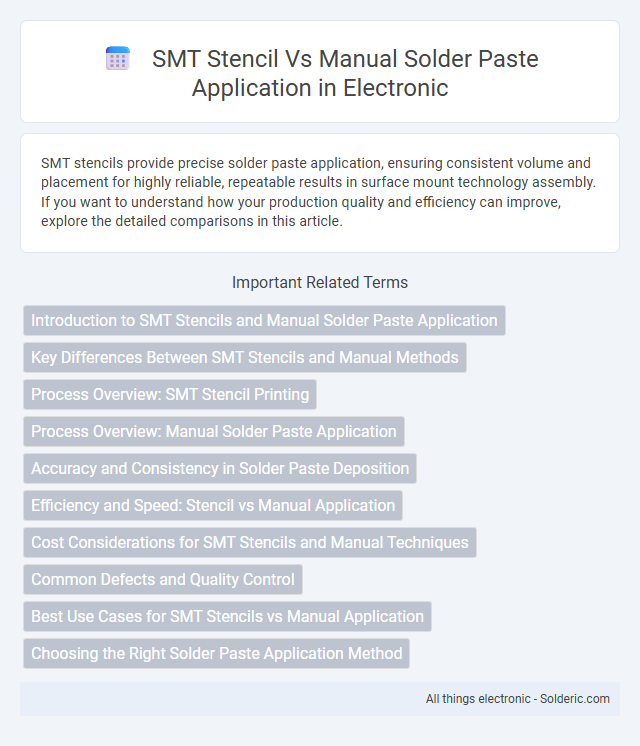SMT stencils provide precise solder paste application, ensuring consistent volume and placement for highly reliable, repeatable results in surface mount technology assembly. If you want to understand how your production quality and efficiency can improve, explore the detailed comparisons in this article.
Comparison Table
| Feature | SMT Stencil Solder Paste Application | Manual Solder Paste Application |
|---|---|---|
| Precision | High accuracy and uniform paste deposition | Inconsistent and less precise application |
| Speed | Fast and suitable for mass production | Slow, suitable for prototypes or small runs |
| Repeatability | Excellent repeatability for multiple boards | Poor repeatability, dependent on operator skill |
| Cost | Higher initial cost due to stencil fabrication | Low initial cost, no stencil required |
| Setup Time | Longer setup due to stencil alignment | Minimal setup time |
| Application Complexity | Ideal for complex, fine-pitch components | Challenging for fine-pitch and high-density PCBs |
| Material Waste | Reduced paste waste with controlled application | Higher paste waste due to manual handling |
Introduction to SMT Stencils and Manual Solder Paste Application
SMT stencils ensure precise solder paste deposition by using thin metal sheets with laser-cut apertures aligned to PCB pads, resulting in consistent solder volume and improved component placement accuracy. Manual solder paste application involves applying paste using tools like syringe dispensers, offering flexibility but risking uneven paste distribution and increased defects. Efficient paste application through SMT stencils enhances process repeatability and reduces rework compared to manual methods often used in low-volume or prototype production.
Key Differences Between SMT Stencils and Manual Methods
SMT stencils offer precise, consistent solder paste application by using laser-cut openings aligned to PCB pads, ensuring uniform paste thickness and reducing defects in surface mount technology assembly. Manual solder paste application relies on operator skill, often resulting in variable paste deposition that can cause insufficient or excessive solder, leading to potential connection failures. You benefit from SMT stencils' repeatability and efficiency, which significantly improve solder joint quality compared to the inconsistent nature of manual methods.
Process Overview: SMT Stencil Printing
SMT stencil printing uses a precisely etched metal stencil aligned over the PCB to apply solder paste accurately onto pads, ensuring consistent volume and placement. This automated process enhances repeatability and reduces solder paste waste compared to manual application, which relies heavily on operator skill and can result in variability. By using stencil printing, your assembly benefits from improved solder joint quality and faster production cycles.
Process Overview: Manual Solder Paste Application
Manual solder paste application involves using a syringe or dispensing needle to apply the solder paste directly onto the PCB pads, allowing for flexibility in prototype or low-volume production. This process requires skilled operators to ensure consistent deposit volume and placement accuracy, which is crucial for preventing solder bridging or insufficient solder joints. While manual application is cost-effective for small batches, it often results in lower repeatability and increased risk of human error compared to SMT stencil printing.
Accuracy and Consistency in Solder Paste Deposition
SMT stencil solder paste application ensures higher accuracy and consistency by precisely controlling the volume and placement of solder paste on PCB pads, reducing the risk of defects such as bridging or insufficient solder. Manual solder paste application often results in variability due to human error, leading to inconsistent paste thickness and potential misalignment. You benefit from improved quality and reliability in your assemblies when choosing stencil printing over manual application.
Efficiency and Speed: Stencil vs Manual Application
SMT stencil application offers significantly higher efficiency and speed compared to manual solder paste application due to its ability to deposit precise, uniform amounts of solder paste simultaneously across multiple pads. Manual application is time-consuming and prone to inconsistencies, leading to increased rework and reduced throughput. High-volume electronics manufacturing favors stencil printing for its repeatability and rapid processing, enabling faster assembly line cycles.
Cost Considerations for SMT Stencils and Manual Techniques
SMT stencil printing typically involves higher upfront costs due to stencil fabrication and setup but offers consistent solder paste deposition and reduces waste, leading to cost savings in large-scale production. Manual solder paste application requires minimal initial investment but results in slower throughput, increased paste wastage, and higher labor costs over time. For high-volume manufacturing, SMT stencils provide a more cost-effective solution, whereas manual methods may suit prototyping or low-volume runs due to lower capital expenditure.
Common Defects and Quality Control
SMT stencil solder paste application offers precise paste deposition, reducing common defects like bridging, insufficient solder, and tombstoning compared to manual methods. Manual solder paste application often results in inconsistent paste volume and placement, leading to higher defect rates and unreliable electrical connections. Quality control for stencil application typically involves automated inspection systems such as SPI (Solder Paste Inspection), ensuring consistent solder volume and placement to improve overall PCB assembly reliability.
Best Use Cases for SMT Stencils vs Manual Application
SMT stencils are ideal for high-volume PCB assembly and precise, repeatable solder paste deposition on fine-pitch components, ensuring consistent solder joints and reducing defects in mass production. Manual solder paste application suits prototype development, small batches, or repairs where flexibility and speed are crucial but precision and repeatability are less critical. Choosing SMT stencils enhances efficiency and uniformity in complex PCB designs, while manual methods provide adaptability for quick or low-volume tasks.
Choosing the Right Solder Paste Application Method
Selecting the optimal solder paste application method hinges on factors such as production volume, precision requirements, and component density. SMT stencil printing offers high repeatability, accuracy, and efficiency for mass production, especially with fine-pitch components, whereas manual application suits prototypes, small batches, or rework where flexibility is critical. Evaluating the trade-offs between process control, time investment, and consistency ensures streamlined assembly and high-quality solder joints.
SMT stencil vs manual solder paste application Infographic

 solderic.com
solderic.com